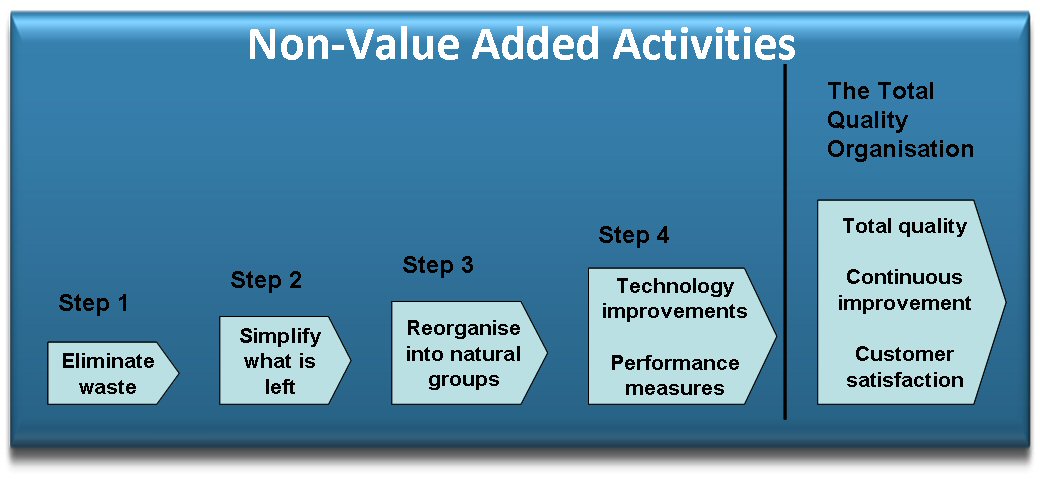4.12 - Non-Value Added Activities
Overview
The set of principles driving the famous Toyota Production System includes a focus on continually attacking and eliminating wasteful activities and unnecessary complexity of processes.
Non-Value Added (NVA)
A non-value added activity is anything costing money or time that is not a direct requirement of the customer and is actually a consequence of bad system design, typically: transport, storage and checkingValue added activities are anything that the customer is prepared to pay for, because he perceives their effect in the value obtained for the money he pays for the productNote that NVA in excess of 60% is not uncommon.
For overhead analysis the needs of both internal and external customers must be established. All NVA is waste and a target for elimination.
Being more competitive means we must reduce cost at an accelerated rateThe area of greatest potential is that of overhead labour costs. Overhead reduction needs to happen in parallel with, but just behind Manufacturing re-design (i.ewe need to re-design the overhead to support the re-designed manufacturing facility).
The 4 Step Approach
The basic 4 step approach to the elimination of NVA is the start of the journey to Total Quality and is shown below:-

Step 1 - Elimination of Waste
Step 1 is the data collection and analysis stage for the complete approachIt starts with the construction of a resource map of the whole business. Its an overview of the complete business to provide an understanding of “How many people?”, “Doing what?”, “Where in the organisation?”, and “For what customer?”
The following techniques are used:-
- Process Flow Chart drawings for paper flows
- I / O analysis to find unnecessary outputs from each department
- From / To analysis - department to department
- System Schematics for all major flows (i.e. total business process block diagram)
- Cascade I / O for complete business to ensure an integrated design
- Determine priority areas of attack using pareto payoff analysis
- Carry out detailed flow chart analysis of 80% of the resource, pareto style
- Determine a detailed plan to reduce NVA by 50% in 6 months
Step 2 - Simplify what is left
Only simplify what cannot be eliminated
Step 3 - Reorganise into Natural Groups
Group people around a significant information flow process to give:-
- Total ownership of and hence clear responsibility for complete flows and whole business processes
- Minimum NVA
- Communication based on people talking directly to each other, not complex paperwork systems or computer systems
- Multi-skilled flexible teams each with properly designed performance measures to suit the business process they control
Only form natural groups/teams AFTER NVA elimination & simplification
Step 4 - Technology Improvements
After elimination of waste, simplification of what is left and re-organisation into natural groups, it is possible to apply simple cost effective technology improvements. This is much like cell control systems in manufacturing that make effective use of less complex technology.